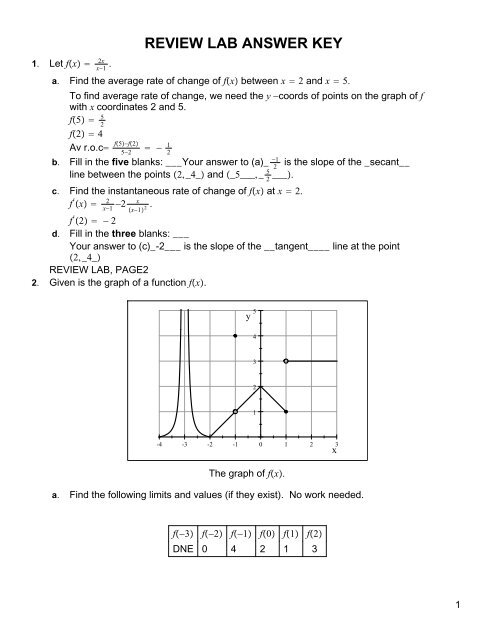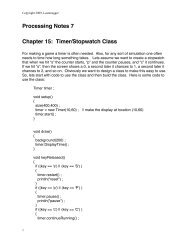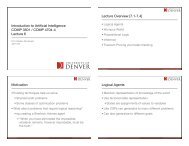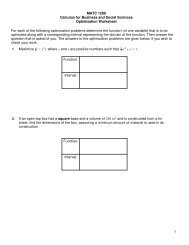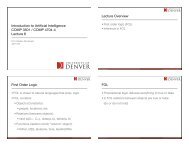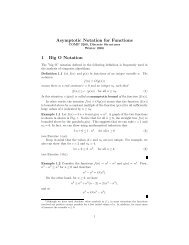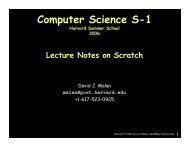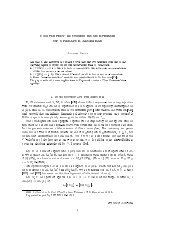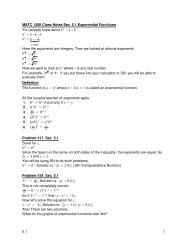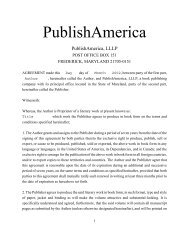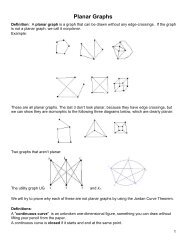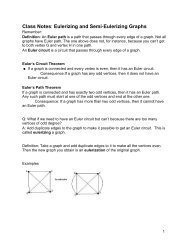Answer key to review lab
Answer key to review lab
Answer key to review lab
You also want an ePaper? Increase the reach of your titles
YUMPU automatically turns print PDFs into web optimized ePapers that Google loves.
REVIEW LAB ANSWER KEY1. Let fx 2x . x−1a. Find the average rate of change of fx between x 2 and x 5.To find average rate of change, we need the y −coords of points on the graph of fwith x coordinates 2 and 5.f5 5 2f2 4Av r.o.c f5−f2 − 1 5−2 2b. Fill in the five blanks: ___Your answer <strong>to</strong> (a)_ −1 is the slope of the _secant__2line between the points 2,_4_ and _5___,_ 5 ___. 2c. Find the instantaneous rate of change of fx at x 2.f ′ x 2 −2 x−1x.x−1 2f ′ 2 − 2d. Fill in the three blanks: ___Your answer <strong>to</strong> (c)_-2___ is the slope of the __tangent____ line at the point2,_4_REVIEW LAB, PAGE22. Given is the graph of a function fx.y54321-4 -3 -2 -1 0 1 2 3The graph of fx.a. Find the following limits and values (if they exist). No work needed.xf−3 f−2 f−1 f0 f1 f2DNE 0 4 2 1 31
lim fx DNE () limx→−3− fx 0x→−2 −lim fx 1x→−1 −lim fx 1x→1 −lim fxDNE () limx→−3 fx 0x→−2 lim fx 1x→−1 lim fx 3x→1 limx→−3fx DNE limx→−2 fx 0lim fx 1x→−1lim fx DNEx→1b. Assume that the domain of this function includes all x − values <strong>to</strong> the left and righ<strong>to</strong>f the viewing window. With that information, determine:limx→fx 3 limx→− fx 0notice that on the left hand side of the picture, the graph is swooping down andapproaching the x-axis. That is why I determined the limit at - is 0, since thex-axis is the line y0.On the right hand side the function has become horizontal with height 3 so thelimit at is 3.c. Is the function f continuous at x −1? Justify your answer by explaining whetheror not f satisfies each of the conditions in the formal definition of continuity.The function has value 4 at -1 but the limit at -1 was 1. Since the value of thefunction is not equal <strong>to</strong> the limit, the third condition of the definition of continuity isnot met. (Visually we have a hole in the graph and a point elsewhere) so thefunction f is not continuous at x-1.d. Use the definition of the derivative <strong>to</strong> determine whether or not f isdifferentiable at x 0.Notice visually that the function has a "sharp corner" at 0. But <strong>to</strong> use thedefinition of the derivative I need <strong>to</strong> turn "sharp corner" in<strong>to</strong> a mathematicalargument. It should go something like this:From the left, the slope of the tangent lines at 0 should be positive (heading up).fxh−fxhThis suggests the left hand limit of should be positive. But on the right of0, the function is heading sharply down, which means that the right hand limit offxh−fxwould be negative. Since these limits aren’t the same,hfxh−fxlim h→0 DNE so the derivative does not exist there. That means f is nothdifferentiable at x0.REVIEW LAB, PAGE 33. (Tan 3.1 #73)The body mass index (BMI) measures body weight in relation <strong>to</strong> heigh. ABMI of 25 <strong>to</strong> 29.9 is considered overweight, a BMI of 30 or more is considered obese, anda BMI of 40 or more is morbidly obese. The percent of the U.S. population that is obese isapproximated by the functionPt 0.0004t 3 0.0036t 2 0.8t 12 0 ≤ t ≤ 13where t is measured in years, with t 0 corresponding <strong>to</strong> the beginning of 1991.a. What percentage of the U.S. population was deemed obese at the beginning of1991?2
P0 0.00040 3 0.00360 2 0.80 12 12 percentb. What percentage of the U.S population was deemed obese at the beginning of2004?2004-1991t13P13 23. 887percentc. What was the average rate of change of the percent of the population deemedobese from 1991 <strong>to</strong> 2004?P13−P013−0 0.9144percent per yeard. How fast was the percent of the U.S. population that is deemed obese changingat the beginning of 1991?IusedSN<strong>to</strong>calculateformethatP ′ t 0.0012t 2 0.0072t 0.8.P ′ 0 0.8 so the percent of obese people was changing by 0.8percent/year atthe beginning of 1991.e. How fast was the percent of the U.S. population that is that is deemed obesechanging at the beginning of 2004?2004 corresponds <strong>to</strong> t13. P ′ 13 1. 0964So the percent of obese people waschanging by 1.0694 percent/year at the beginning of 2004.f. Based on the derivative of the function Pt, will tne percentage of the populationdeemed obese be increasing or decreasing in 2008?2008 corresponds <strong>to</strong> t17. P ′ 17 1. 2692 0 so the percentage deemedobese will still be increasing because the derivative is positive.REVIEW LAB, PAGE 44. Let fx 2x 4 − x 2 − 4. UseSN<strong>to</strong>giveacarefulsketchoffx for the following twowindows. Notice that the one on the left is zoomed in more.-1.0 -0.5 0.0 0.5 1.0y-3-4xy40302010-5-3 -2 -1 1 2 3x-10a. Use the limit definition of the derivative <strong>to</strong> find f ′ x by doing the following:fxh−fxi. Find the unsimplified difference quotient for fx.Make sure <strong>to</strong>huse enough parentheses.fxh−fxh 2xh4 −xh 2 −4−2x 4 −x 2 −4hii. Use SN <strong>to</strong> simplify your difference quotient.2xh 4 −xh 2 −4−2x 4 −x 2 −4 − 1 h x 2 − 2h x 4 − x 2 2x 4 h h2h 3 8h 2 x 12hx 2 −h 8x 3 −2xiii. By hand (versus using SN),take the limit as h → 0. lim h→0 2h 3 8h 2 x 12hx 2 − h 8x 3 − 2x 20 3 80 2 x 120x 2 − 0 8x 3 − 2x 8x 3 − 2xlim h→0fxh−fxh3
So,f ′ x ________8x 3 − 2x_________b. For what x −value(s) is the tangent line <strong>to</strong> fx horizontal? Draw those line(s) inthe graph on the left.8x 3 − 2x 0, Solution is: 1 ,0,− 1 So draw the horizontal lines tangent <strong>to</strong> the2 2graph through the points with x coords .5, 0, -.5 See them on the picture?c. Find the equation of the tangent line <strong>to</strong> fx at x 2. Draw your tangent line inthe graph on the right.f ′ 2 60slope of tangent line. f2 24.0equation: y 60x − 2 24d. By using your answer <strong>to</strong> part (b) and looking at the graph of fx, over whatinterval(s) is f ′ x 0 and over what intervals is f ′ x 0?The derivative is positive when the function is increasing, so between - 1 and 0 21and <strong>to</strong> the right of . The derivative is negative when f is decreasing, left of − 1 ,2 20<strong>to</strong> 1 . 2In interval notation the correct answers are:−,− 1 0, 1 2 2 f′ 0.− 1 ,0 1 2 2 ,,f′ 0.REVIEW LAB, PAGE 55. Evaluate each limit algebraically and show your steps. If you use SN <strong>to</strong> simplify anexpression (and you are encouraged <strong>to</strong> do so) please indicate at which step. You mayuse SN <strong>to</strong> check your answer, but solely giving the answer is not enough work in general.a. lim −2x 2 − 4x 70x→1 3x 2 − 30x 75 4 3First try plugging in on <strong>to</strong>p and bot<strong>to</strong>m.−21 2 − 41 7031 2 − 301 75 I evaluate in SN and get −212 − 41 70 64 and31 2 − 301 75 48. since these are numbers and the bot<strong>to</strong>m is nonzero, their64quotient is the limit, 4 48 3b. lim −2x 2 − 4x 70x→5 3x 2 − 30x 75 DNEFirst try plugging in on <strong>to</strong>p and bot<strong>to</strong>m.−25 2 − 45 70 035 2 − 305 75 0 this is a 0/0 situation so I need <strong>to</strong> have SN fac<strong>to</strong>r the <strong>to</strong>pand bot<strong>to</strong>m.SN fac<strong>to</strong>rs the <strong>to</strong>p: −2x 2 − 4x 70 − 2x 7x − 5SN fac<strong>to</strong>rs the bot<strong>to</strong>m: 3x 2 − 30x 75 3x − 5 2Now I look at my new quotient: −2x 2 − 4x 703x 2 − 30x 75 −2x7x−5 − 2x7 plug 5 in<strong>to</strong>3x−5 23x−5<strong>to</strong>p and bot<strong>to</strong>m again.25 7 24 35 − 5 0 we have 24/0 so that means the expression isundefined and the limit DNE,c. lim −2x 2 − 4x 70x→−7 3x 2 − 30x 75 0First try plugging in on <strong>to</strong>p and bot<strong>to</strong>m.−2−7 2 − 4−7 70 03−7 2 − 30−7 75 4324
since these are numbers and the bot<strong>to</strong>m is nonzero, their quotient is the limit,0432 0d. limx 4 10x 3 35x 2 50x 24 DNEx→−3 x 4 6x 3 5x 2 − 24x − 36First try plugging in on <strong>to</strong>p and bot<strong>to</strong>m. −3 4 10−3 3 35−3 2 50−3 24 0−3 4 6−3 3 5−3 2 − 24−3 − 36 0this is a 0/0 situation so I need <strong>to</strong> haveSN fac<strong>to</strong>r the <strong>to</strong>p and bot<strong>to</strong>m.x 4 10x 3 35x 2 50x 24 x 4x 3x 2x 1x 4 6x 3 5x 2 − 24x − 36 x − 2x 2x 3 2So now we divide and cancel like terms,x4x3x2x1x−2x2x3 2 x1x4x−2x3Note now if you plug in -3 <strong>to</strong> the <strong>to</strong>p, you get (-2)( 1)-2 and in the bot<strong>to</strong>m you get(-5)(0)0.Since this is in the form (nonzero number)/0, the limit will not be defined and thusyou write DNE (SN will evaluate it as "undefined").x 4 10x 3 35x 2 50x 24 1x→−2 x 4 6x 3 5x 2 2− 24x − 36e. limNotice this is the same function as in part d, but we’re taking the limit at adifferent point. So <strong>to</strong> start with I’m just going <strong>to</strong> use the simplified, fac<strong>to</strong>red formof x4 10x 3 35x 2 50x 24x1x4that we got above: . Notice when you plugx 4 6x 3 5x 2 − 24x − 36x−2x3in -2 everywhere, you getso this is the limit.f. lim x→−21−24−2−2−23 1 22x 3 2xx 4 − x 3 1 0This is a limit at infinity. So <strong>to</strong> do it remember how I taught you in class: divide out the <strong>to</strong>pand bot<strong>to</strong>m by the largest power of x present anywhere. In this case, we divide the <strong>to</strong>p andbot<strong>to</strong>m by x 4 since that’s the largest present. Note that SN won’t be able <strong>to</strong> help you withthis sort of dividing; you’ll have <strong>to</strong> use your own knowledge of exponents and division <strong>to</strong> doit.2x 3 2xx 4x 4 −x 3 1x 42x 3x 4 2xx 4x 4x 4 − x3x 4 1x 42x 2x 31x 4 − 1 x 1Now we know that:2 2 1x , , ,− 1 x 3 x 4 x allgo<strong>to</strong>0whenx → while 1 is still 1 at infinity. so we’ve got:00 0 is the limit at infinity.001REVIEW LAB, PAGE 6Below this line are problems that you should be able <strong>to</strong> do WITHOUT SN at all, and in anexam you should be prepared <strong>to</strong> solve problems like this without technology.6. You are given the following table of values for fx.x 4.9 4.99 4.999 4.9999 5 5.0001 5.001 5.01 5.1fx 47. 61 48. 8601 48. 9860 48. 9986 10 36. 001 36. 0120 36. 1201 37. 21a. Evaluate f5105
. Evaluate lim fxx→536c. Evaluate lim fxx→5−49d. Evaluate limfxx→5Does not exist, since left and right limits are different.e. Is fx continuous at x 5? Explain your answer by referring <strong>to</strong> the formal (limit)definition of continuity.No, since the limit doesn’t exist at 5 and therefore the limit and the function can’tbe equal there.7. Without using SN, find the derivative of each of the following (you do not need <strong>to</strong> simplifyyour answers):a. fx 3x 3 − 5x −1 x − 6f ′ x 33x 2 − 5−1x −2 1 0b. gx 4 x 2 x 1x −21notice the trick here! x 2x −2g ′ x 4 1 2 x 1 2 −1 2− 1 2 x− 1 2 −1 2x 2−1 c. hx 3 x 10 − 6x −5/3 16x 4we’ll do the last 4 of these in class....d. fx x 7x −5 3 1 x − 5xwe’ll do the last 4 of these in class....e. fx 7x2 − 7x −2 3x 4 − 10we’ll do the last 4 of these in class....f. fx 1 x − 73x 3x4 3x −6 − 7 5xwe’ll do the last 4 of these in class....6


